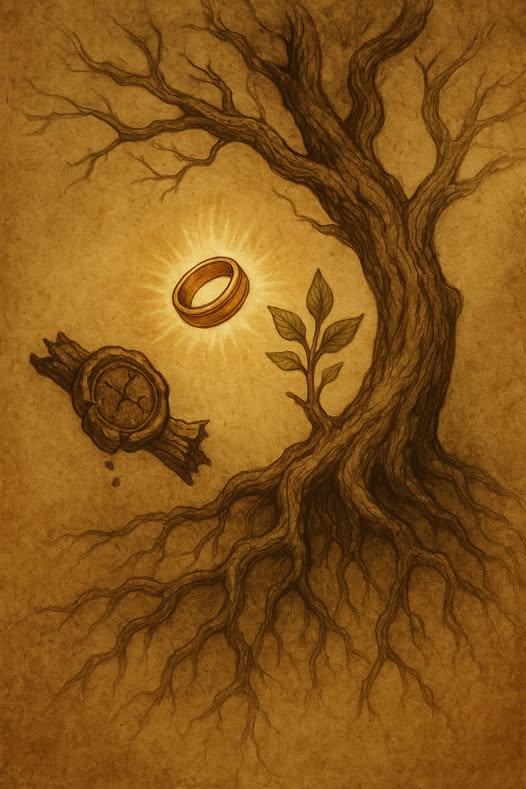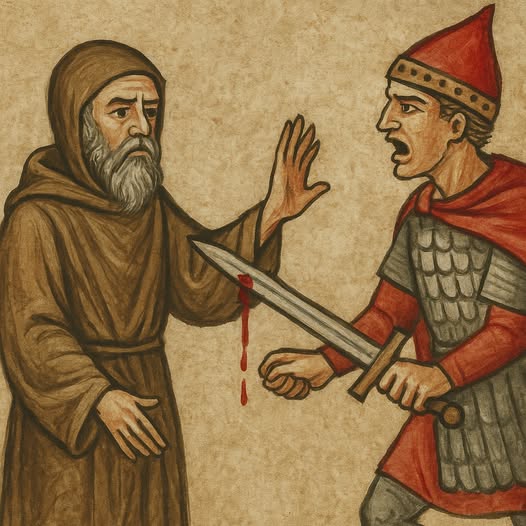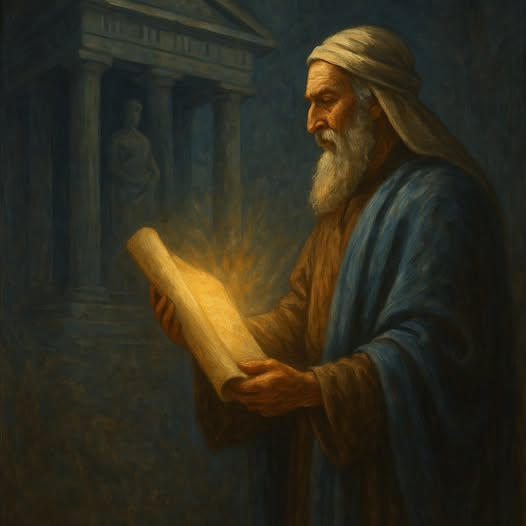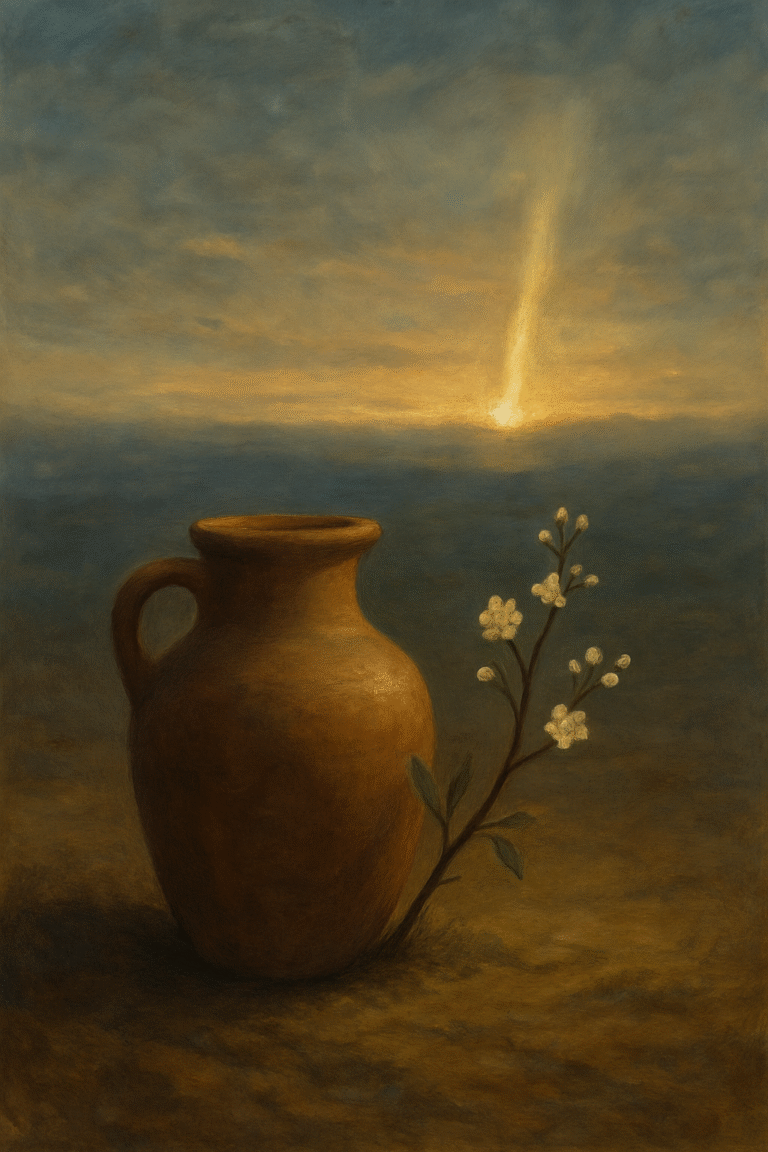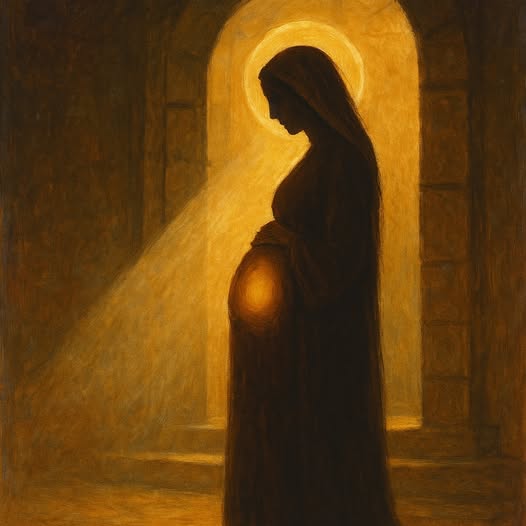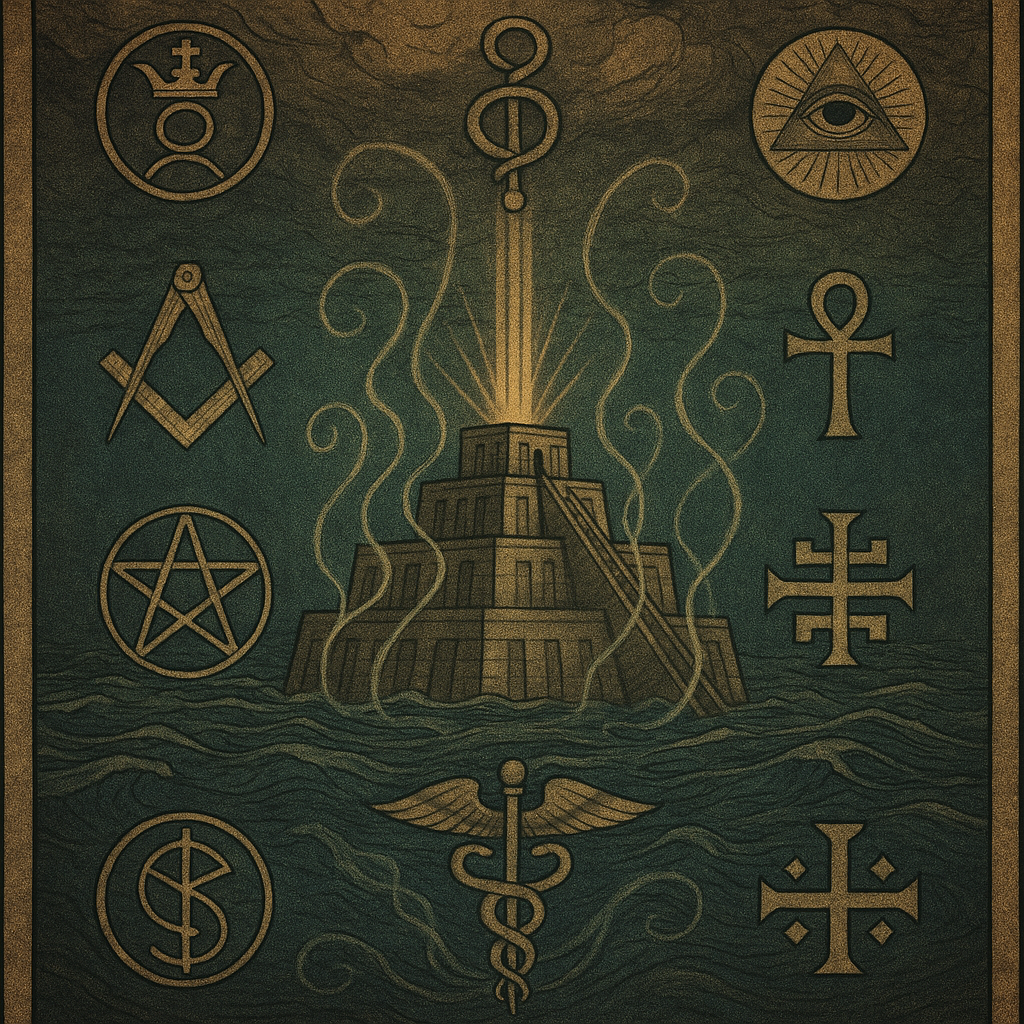
According to the Book of Enoch and other Second Temple texts, the Flood was not only a judgment on human wickedness, but a divine intervention to purge the world of knowledge that had been misused. The Watchers, fallen heavenly beings, had descended and taught humanity things they were not meant to know—sorcery, astrology, the use of roots and herbs, weapon-making, seduction, and the crafting of spirits. While not all of these arts were evil in themselves, the motives behind their dissemination and the corrupt state of the world ensured that they led to ruin.
When the Flood came, that knowledge was not accidentally lost. It was intentionally erased by God. But humanity, ever unwilling to accept divine boundaries, preserved whispers of it through myth, mystery, and hidden teachings. Alchemy, with its promise of transformation and divine power, did not arise out of purity or wisdom. It was the continuation of a rebellion that the waters of judgment were meant to drown.
The Apkallu: Divine Sages and the Corruption of Kingship
In Mesopotamian tradition, the Apkallu were divine or semi-divine sages who brought knowledge and civilization to humanity. They were credited with teaching arts, sciences, writing, and magic, tools of great power that elevated kings and rulers who claimed descent from them. These sages were said to have served as advisors to early kings and were revered as the ultimate sources of wisdom. Even after the flood, their influence persisted in the form of lesser Apkallu, beings who were part divine, part human, and still bearers of forbidden knowledge.
But Genesis presents a strikingly different picture. It casts these “sages” in a far more ominous role. Rather than guiding kings to justice and order, they are associated with the corruption that made the Flood necessary. This view is developed further in 1 Enoch, where the Watchers, the rebellious sons of God, descend and give forbidden knowledge to their hybrid offspring and through them to the world. In this telling, the Apkallu become the originators of occult knowledge, weapons of war, and sorcery, tools that deformed the image of God in mankind.
The tyrant kings of the ancient world were not merely claiming divine right. They were establishing power through a lineage that connected them to these rebellious beings. Their rule was based not on righteousness, but on dominance and divine rebellion. The Apkallu were not neutral civilizers, but part of a cosmic revolt that spread corruption through secret knowledge passed down to those who would grasp at divinity on their own terms.
The Alchemical Pursuit of a Forbidden Order
Alchemy was never about mere chemistry. It was a spiritual and philosophical system obsessed with recovering divine power without divine permission. The alchemist’s laboratory was not a place of science, but of sorcery. The goal was to transmute base matter into perfection, but more than that, it was about transforming the self into a godlike being, bypassing the curse of mortality.
Though often dismissed today as a medieval curiosity, alchemy was not a fringe endeavor. It was taught at major European universities well into the 19th century. Institutions that outwardly professed Christian values integrated the language and structure of alchemy into medical, chemical, and philosophical studies. This academic acceptance did not purify it. Instead, it allowed the pursuit of forbidden transformation—both material and spiritual—to pass as respectable science. The language shifted, but the underlying goal remained: to recover what God had judged and removed.
This reflects not restoration, but rebellion. The alchemist, like the builders of Babel, was not simply trying to ascend to heaven in pride but was attempting to reassemble the divine knowledge and connection that God had severed in judgment. Babel was an effort to reconstruct the gateway between heaven and earth, just as alchemy seeks to reverse the effects of divine separation. The language of purification and transformation serves as a cloak for the deeper agenda—to recover the power structure of the pre-Flood world and to restore what God intentionally destroyed.
The Tablets of Thoth: Echoes of Antediluvian Rebellion
Despite their prominence in occult tradition, the Tablets of Thoth have no basis in history or Scripture. They are part of a constructed mythos developed long after the Flood, designed to give forbidden knowledge the appearance of sacred antiquity. In Egyptian lore, Thoth was the god of wisdom, writing, and cosmic balance. Later esoteric traditions, especially Hermeticism, merged Thoth with the Greek Hermes to create Hermes Trismegistus, the supposed author of the Emerald Tablet and the Hermetic Corpus.
These writings claim to contain secret knowledge of the universe—spells, resurrection formulas, alchemical instructions, and celestial patterns. But this is not divine truth preserved. It is a counterfeit framework constructed to justify spiritual rebellion. The phrase “as above, so below” does not mirror the biblical relationship between heaven and earth. It reflects a belief that man can manipulate divine order to serve his own purposes.
Traditions claiming that this knowledge was hidden before the Flood do not reflect divine preservation, but the stubborn refusal of fallen humanity to release what God had condemned. Their story survives not as a record of truth, but as a seductive lie permitted by God to expose the hearts of those who long for power without obedience. These tablets are not sacred relics—they are symbols of spiritual defiance masquerading as wisdom.
Freemasonry and the Ritualized Rebellion
Freemasonry participates in the same post-Flood pattern of spiritual defiance that seeks to reclaim what God destroyed. It repurposes biblical names, sacred architecture, and covenantal imagery—not to honor God, but to construct a parallel system of hidden ascent built on forbidden knowledge.
Central to Masonic legend is the idea that Enoch carved divine secrets into stone pillars and hid them underground before the Flood. This story, like the myth of the Tablets of Thoth, was invented to legitimize the idea that condemned knowledge was not lost but preserved for the enlightened. It reframes judgment as an obstacle to be overcome.
Freemasonry invokes figures like Enoch, Solomon, and the Temple, but only to strip them of their true meaning and assign them new roles in a ritual system that leads not to God, but to the self. The ascending degrees, the pursuit of the “lost word,” and the promise of inner light reflect the same core agenda behind Babel and alchemy—to rebuild Eden without repentance, to bypass the cross, and to elevate the self through knowledge rather than submission. This is not ancient truth preserved. It is rebellion enshrined.
Alchemy in the Islamic World: Preserving and Transmitting Forbidden Knowledge
While alchemy is often associated with medieval Europe and later occult movements, its most significant development occurred under the banner of Islam. The Islamic Golden Age not only preserved Greco-Egyptian alchemical texts but expanded, systematized, and spiritualized them. This was not merely the result of intellectual curiosity; it was a continuation of the same ancient quest to reclaim what had been lost at the Flood.
The word alchemy itself derives from Arabic, al-kīmiyā’ (الكيمياء), a term adapted from the Greek khemeia, meaning “art of transmutation.” Under Islamic scholars, alchemy was more than a technical art. It became a sacred science. Jābir ibn Hayyān, known in the West as Geber, is often considered the father of modern chemistry. But his voluminous works reflect more than chemical experimentation. They are saturated with Shi’a esotericism, astrological symbolism, and the conviction that physical transformation mirrored spiritual ascent. Influenced by the belief in batin, or hidden knowledge, Jābir saw alchemy as a divine pursuit aligned with the secrets allegedly granted to pre-Flood figures like Enoch.
Sufi mystics later embraced alchemy as a metaphor for purifying the soul. The nafs, the lower self, was to be refined like base metal into spiritual gold. This spiritualized approach lent alchemy an air of religious legitimacy, even as it ventured into speculative and magical territory. Beneath the mystical language was a deeper theme: the restoration of lost wisdom, concealed by God, yet still sought by man.
It Was Never Innocent
The knowledge that was destroyed in the Flood was not lost unjustly. It was a mercy to erase it. Scripture shows that the earth had become filled with violence, corruption, and demonic influence. The removal of that knowledge was part of God’s cleansing work. Every attempt to recover it, whether through alchemy, Hermeticism, or Masonic rites, is a rejection of that judgment.
Those who pursue this path often invoke Enoch or Solomon to justify their search. But this is deception. Enoch was a righteous man, taken by God, not a revealer of sorcery. Solomon was wise when he submitted to Yahweh, but his heart turned when he allowed foreign worship to creep in. These figures are co-opted precisely because of their righteousness, giving a veneer of credibility to those seeking forbidden things. This is not about wisdom. It is about power without obedience.
Other Secret Paths to Forbidden Knowledge
Alchemy and Freemasonry are not isolated anomalies. They are part of a much larger web of secret societies, esoteric movements, and mystical crafts that all trace their lineage, symbolically or explicitly, back to the antediluvian rebellion. Though they use different symbols and languages, these groups share a common goal: the recovery of knowledge God destroyed, and the restoration of power God removed.
Rosicrucianism: The Brotherhood of the Hidden Light
Emerging in the 17th century, Rosicrucianism claimed descent from a hidden brotherhood preserving secret wisdom passed down from ancient times. The mythic founder, Christian Rosenkreuz, supposedly traveled through the East, gathering divine knowledge before forming a spiritual order dedicated to reforming religion and science.
But this was no reformation of worship. Rosicrucian texts blend alchemy, Hermeticism, astrology, and mystical rites, all aimed at transcending the limitations placed on mankind after the Fall and the Flood. Like Freemasonry, Rosicrucianism cloaked itself in Christian symbolism while promoting a path of illumination that bypassed the cross.
Theosophy: A Rewriting of the Fall
Founded by Helena Blavatsky in the 19th century, Theosophy presented itself as the universal religion behind all others. It drew heavily from Hinduism, Buddhism, Gnosticism, and Hermeticism, but its true aim was to restore the spiritual knowledge of lost civilizations, particularly Atlantis and Lemuria—mythic echoes of the pre-Flood world.
Theosophy teaches that man is evolving toward divinity, and that spiritual “Masters” preserve the truth in secret. In this system, the God of the Bible is portrayed as a lesser being, and salvation comes not through Christ, but through awakening ancient wisdom. Theosophy is Gnosticism repackaged for the modern world.
Occult Kabbalah: Weaponizing Mysticism
While classical Jewish Kabbalah focuses on the mystical interpretation of Scripture in devotion to Yahweh, the occult branches that arose during the Renaissance separated Kabbalah from obedience. These forms often included angelic invocations, magical diagrams, and attempts to manipulate divine names.
By divorcing the pursuit of knowledge from holiness, these practices mirrored the transgressions of the Watchers, treating the sacred as a tool. Enoch is again invoked, but as a magician, not a prophet. Divine order becomes something to be controlled, not submitted to.
Gnosticism: The Oldest Lie in a New Tongue
Gnosticism teaches that the material world is a prison created by an ignorant or evil god, and that secret knowledge—gnosis—liberates the soul. The serpent becomes the hero. Yahweh becomes the jailer. The Flood becomes a crime.
This inversion is central to nearly every occult tradition. It turns rebellion into virtue. Gnosticism does not just misunderstand the Bible. It systematically rewrites it, transforming every act of judgment into oppression and every act of obedience into blindness.
The Golden Dawn and Ritual Magic Orders
The Hermetic Order of the Golden Dawn, formed in the late 19th century, formalized rituals blending alchemy, astrology, Kabbalah, and Egyptian magic. Successors like Ordo Templi Orientis and others followed suit. These orders sought direct contact with spiritual beings, invoking and commanding powers once feared.
This is not metaphor. These rituals are explicit invocations. Their goal is power. Their means are forbidden. And their foundation is the belief that divine law can be bent by ancient technique, just as the Watchers once taught.
Luciferianism and Prometheanism: Open Rebellion
Some movements drop the mask entirely. In Luciferianism, the Fall is seen as liberation. In Promethean spiritualism, divine fire is stolen as a heroic act. Whether religious or secular, these movements cast judgment as tyranny and knowledge as salvation. They honor the serpent as the first liberator.
These philosophies do not appeal to subtlety. They are the final stage in the pattern, the point where rebellion is no longer hidden but exalted.
The Alchemical Roots of Psychology
What many forget is that alchemy did not vanish. It evolved.
Into the 19th century, alchemy was still taught at universities, sometimes under the guise of “natural philosophy.” One of its most influential inheritors was Carl Jung. Jung, one of the fathers of modern psychology, drew extensively on alchemical texts. He believed they represented symbolic processes of individuation—the journey toward self-realization and psychological wholeness.
To Jung, alchemical symbols mirrored the human psyche. The Philosopher’s Stone became a symbol for the perfected self. The union of opposites in alchemy (male and female, sun and moon, spirit and matter) represented psychological integration.
But Jung’s system, though framed in therapeutic language, still carried the imprint of its alchemical roots. It was a quest for transformation without repentance, integration without surrender, wholeness without God. Psychology, especially in its esoteric and archetypal forms, became a modern path to forbidden knowledge, offering salvation through self-realization rather than through the Savior. While modern clinical psychology is diverse and includes many helpful practices, its historical roots lie in movements that sought to elevate the self as ultimate. More troublingly, in recent years, some corners of the psychological community have used its tools to blur moral lines. Rebranding pedophilia under sanitized terms like “Minor Attracted Persons” shows how easily a system can be bent to serve rebellion rather than redemption.
From Cloaked Ritual to Open Defiance
These movements, ancient and modern, mystical and philosophical, are not divergent paths. They are branches from the same corrupted root. They offer the same promise that the serpent whispered in Eden: “You will be like God.” Whether shrouded in mystery or flaunted in defiance, they all lead away from repentance and toward self-exaltation. They do not seek truth. They seek power stolen from Heaven. And like the knowledge before the Flood, their end is destruction.
Conclusion
Alchemy, the Tablets of Thoth, Freemasonry, and their many cousins are not innocent traditions seeking spiritual enlightenment. They are expressions of mankind’s unwillingness to accept divine limits. They are spiritual insurgencies against a God who judged, erased, and buried corrupt knowledge for the sake of creation itself.
The Flood was not just water. It was a firebreak against the spread of a corruption that had infected both flesh and spirit. The pursuit of that same corruption today, even under the guise of sacred science or ancient wisdom, is rebellion revived. And that is why these traditions so often try to wrap themselves in the language of Scripture. They know what they pursue is forbidden. They know they need a mask.
But there is no mask before the throne of God. No secret wisdom, no ancient formula, no hidden light can substitute for the revealed truth found in God’s Word. The knowledge that redeems is not locked away in pyramids or arcane rites. It was given openly on a cross, and it leads not to godhood, but to worship.
Discussion Questions
- Why did God erase the knowledge taught by the Watchers rather than simply restrict it?
- How does the legend of the Tablets of Thoth reflect mankind’s refusal to accept divine boundaries?
- In what ways do secret societies like Freemasonry and Rosicrucianism repackage ancient rebellion as enlightenment?
- How does invoking figures like Enoch and Solomon serve to justify the pursuit of forbidden knowledge?
- What does the popularity of these movements reveal about modern attitudes toward judgment, obedience, and divine authority?
Want to Know More?
- 1 Enoch (chs. 6–8) – Describes the descent of the Watchers, their corruption of mankind, and the judgment that followed. Essential background for understanding the biblical context of forbidden knowledge.
- Book of Jubilees 10 – Recounts Noah’s plea to God for deliverance from demonic forces and corrupted teachings, offering a Second Temple perspective on the aftermath of the Flood.
- The Emerald Tablet – A foundational Hermetic text often cited in alchemical and occult traditions. Its phrase “as above, so below” encapsulates the worldview of rebellious correspondence between heaven and earth.
- Anderson’s Constitutions of the Freemasons (1723) – Contains the early Masonic legend of Enoch carving divine secrets into stone pillars. Useful for tracing how biblical figures were absorbed into esoteric traditions.
- “Theosophy and the Secret Doctrine” by Helena Blavatsky – Not recommended as a source of truth, but essential for understanding the modern resurgence of antediluvian myths cloaked in spiritual language.

